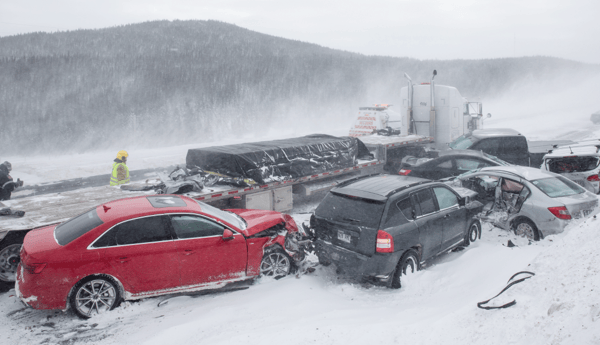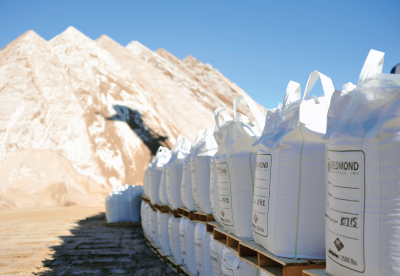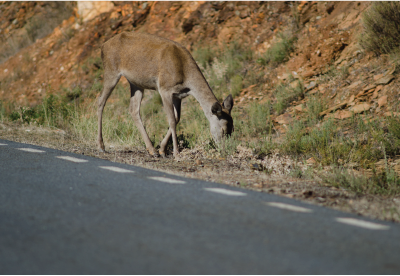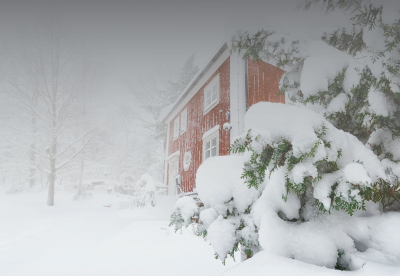Date February 24, 2025 | Brooke Loeffler
How Closed Roads Affect the Economy
Historic Snow Storm Closures
According to the Farmer’s Almanac and The National Snow & Ice Data Center, there have been many epic snowstorms that have immobilized American cities over the past couple centuries.

- 1717: An intense storm dumped snow across New England (records range from 3 feet to drifts 25 feet high). For over a century, this storm was referred to as “The Great Snow.” Moving between New York and Boston became almost impossible. Only a single determined postal runner was able to journey from one city to another after he abandoned his horse for some snow shoes.
- 1772: Known as “The Washington and Jefferson Snowstorm”, this storm famously trapped each founding father in their homes as 3 feet of snow covered Maryland and Virginia.
- 1888: The “Blizzard of ‘88” plunged areas of the country below 0° F and stranded several cities in deep snow drifts. Transportation and communication completely stood still, and New York City suffered the critical damage.
- 1967: A series of record breaking storms off Lake Michigan crippled Chicago. 23 inches of snow stranded thousands in offices, schools, and on buses throughout the city. Around 50,000 abandoned cars and 800 buses clogged streets and prevented emergency measures. It took more than 2 weeks to clear major highways and roads to bring the city back to life.
- 1969: New York City was paralyzed and trapped under a deep blanket of snow that stranded citizens across the city. Mayor Lindsay infamously delayed the snow plow fleet and they were unfortunately buried in their storage lots when they were needed most. Over 10,000 emergency snow workers were hired to begin shoveling out the city by hand.
- 1977: Buffalo, NY was slammed by a storm that killed 28 people and shut down the city for over a week. People remain trapped in schools, stores, and offices as highways remained clogged with thousands of stranded vehicles.
- 1982: The National Guard deployed to St. Louis Missouri to free its inhabitants from a disastrous snowstorm. 18-21 inches of snow crippled the metropolis for as long as a week. All transportation services shut down and hospital and emergency workers worked continuous shifts because no relief could commute. Around 4,000 motorists were stranded in blizzard conditions on highways.
- 1996: 2 sequential blizzards brought the eastern United States to a complete halt and killed over 100 people. For several days, multiple cities were closed as impassable roads prevented commuting to and from airports, schools, homes, offices, and stores.
- 2009-2010: President Obama dubbed the weather events in Washington D.C. as “Snowmageddon.” The nation’s capital was completely shut down for several days after being ill-equipped for the massive snowfall.
- 2014: The streets of Atlanta looked like a disaster movie after a few inches of snow fell over a thin sheet of ice. Most inhabitants hit the roads all at once in an attempt to leave work, buy supplies, and get home. Thousands of students were forced to spend the night at school and commuters abandoned their cars in the icy gridlock to seek shelter.
- 2022: 12 inches of snow completely shut down I-95 in Virginia and stranded hundreds of drivers on the freeway for over 24 hours.
Before the mid 1800’s, municipalities had no effective snow fighting methods in their arsenal. In 1840, the first patent for a snow plow was filed, but was not put into operation until over 20 years later. In 1862, the first snow plow hit the streets of Milwaukee. Finally, America was open to the possibility of clear streets and functioning cities in the winter for the first time in our history.
Our approach to snow removal has evolved over time due to changes in:
- Weather tracking
- Population
- Urban/rural balance
- Transportation methods
- Technological advances
- Environmental understanding, and more.
How Costly Are Closed Roads?
Open roads are the circulatory lifeblood of our rural communities and urban centers. When snow fighting crews set out to clear clogged roads, they are opening arterial pathways that keep our country running. Closed roads have far reaching effects on the health and economy of an area.

Cost of Life
Impassable roads prevent emergency crews (police, ambulances, fire fighters) from responding to incidents. As history has shown, closed roads also prohibit fresh crews from relieving their counterparts at hospitals, emergency rooms, fire stations, police precincts, and more. Exhausted and immobilized crews cannot tend to our everyday needs, let alone the additional needs that arise during hazardous weather.
Cost of Accidents
According to a 2014 study conducted by USA Today, “wintry weather accounted for 40% of pileups.” These roadway crashes are costly in many categories:
- Commuter and pedestrian health (injuries, property damage, loss of work, vehicle repairs, medical expenses)
- Infrastructure (damage to road surfaces, signs, barriers, and debris cleanup)
- Local insurance premiums (spikes in local accident rates cause insurance companies to raise premiums for affected zip codes, which then prices out lower income families and increases the number of uninsured drivers on the road)
- Healthcare organizations (clusters of winter accidents strain medical resources)
- Emergency services (emergency crews have limits on how many incidents they can respond to all at once)
In this same study, USA Today reported that:
“the average roadway fatality costs about $1.32 million in associated economic costs and the average crash with a critically injured survivor costs about $1.5 million, based on a 2002 National Highway Traffic Safety Administration calculation adjusted for today's dollars.”
The Western Transportation Institute (WTI), out of Montana State University, has conducted many studies into winter shutdown economics. They have found that:
“the common winter maintenance practice of deicing has been shown to reduce crash frequency by 88.3 percent, and to decrease the average cost of each crash by 10 percent.”
Cost of Lost Commercial Shipping
Storms don’t just affect the localized area where snow falls. Our vast commercial shipping network contains interconnected hubs. Icy shutdowns in one city harm many other cities as goods and services are immobilized.
The Federal Highway Administration found that:
“Each year trucking companies or CVOs lose an estimated 32.6 billion vehicle hours due to weather-related congestion in 281 of the nation's metropolitan areas. Nearly 12 percent of total estimated truck delay is due to weather in the 20 cities with the greatest volume of truck traffic. The estimated cost of weather-related delay to trucking companies ranges from 2.2 billion dollars to 3.5 billion dollars annually.”
Cost of Lost Work/Productivity
The Global Pandemic has taught us how costly it can be for local, national, and global economies when its workers are prevented from working. The lower to middle class bears the greatest hardship during adverse times. That means, of all the economic groups, hourly workers suffer the most during snow-related shutdowns.
WTI has reported that hourly workers account for “almost two-thirds of direct economic losses” during a snow-related shutdown. WTI also cited that:
“approximately $1.4 billion dollars would be lost in wages alone if all of the snowbelt states were immobilized for just one day due to a winter weather event. Since then that number has climbed closer to $2.6 billion according to IHS Global Insight (Booz Allen Hamilton, 1999; IHS Global Insight, 2014).”
Cost of Lost Retail Sales
Impassable roads prevent the populace from both working and spending. In the same study mentioned above, WTI stated that “the one day loss of retail sales was found to be $870 million (IHS Global Insight, 2014).” The combined impact of loss of work hours plus loss of retail sales would be devastating:
“When looking into the number of dollars lost as a full economic impact at a federal, state, local and individual level the numbers are even more staggering at around $3.9 billion (Booz Allen Hamilton, 1999).”
Clear Winter Roads = Lives and Money Saved

Proper winter road maintenance saves lives and our economy. Some states and municipalities sometimes hesitate when presented with upfront costs for snow plows, a snow fighting workforce, and deicing materials. However, ice prevention and timely snow removal has significant short-term and long term payoffs. The costs of snow-related road closures far exceeds the costs of proper winter road maintenance.
The National Coalition for Open Roads (NCFOR) knows that open roads improve welfare, boost economic growth, and keep the life blood of our communities flowing. NCFOR works with the general public and officials at local, state, and federal levels to educate and encourage best practices to keep roads open during the winter.
Ice Slicer® is proud of our partnership with NCFOR to quickly restore safe and driveable conditions. We have teamed up with states and cities in and out of the snowbelt to reduce accident rates and keep roads open.
Open Road Best Practices
Each snowstorm presents a unique set of challenges, so open road practices will vary by region. Some of these best practices include:
- Anti-icing before storms
- Purchasing deicing stockpiles early
- Proper vehicle and material storage
- Increasing snow fighting crews and vehicles
- Improving off season training for winter crews
- Proper equipment calibration
- Education on responsible deicer application
Policy makers need to conduct cost benefit analyses that balance their needs, weather concerns, and budgets. Luckily, educational resources are available. Contact NCFOR at Info@NCFOR.us or reference WTI’s cost benefit analysis guide. Let’s work together as a team to continue fueling America’s fascination with the open road and improve the winter safety of our communities.
© 2024 Redmond Minerals Inc.






